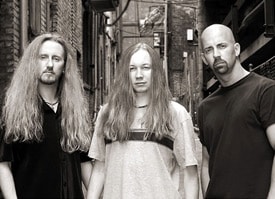Yamaha AW4416 Offers True "DIY" Freedom
 |
Hailing from a city known for producing volumes of Country and Christian music– and virtually overflowing with recording facilities, producers, songwriters and engineers – Dead Air Radio has not only challenged its hometown musical conventions. The band has also challenged the unwritten "studio system" with a real "Do-It-Yourself" approach to production: while recording their debut EP Strange Frequencies, Givens and band mates Dennis Thompson (guitars/vocals), Anthony Kratke (drums) and bassist Dean Mares skipped the traditional multi-tracking approach – and the comfort of a recording studio – to complete the self-produced, self-written and self-recorded EP from the comfort of home, thanks to Givens' Yamaha AW4416 digital audio workstation.
 Dennis Thompson, Bill Givens and original drummer Anthony Kratzky. |
Workstations are really little self-contained studios, and I could justify the cost as an investment, rather than spending even more money on limited studio time. I also wanted work from home, because that's where the ideas really flow."
What began as Givens' self-education on the AW4416 eventually became the six completed songs of Strange Frequencies, and ultimately changed the way Dead Air Radio recorded.
"I was working out guitar lines with existing drum scratch tracks," he says, "and ended up laying down what became the final versions of the guitar, keyboards and vocals. This started out as an exercise in preproduction, but since everyone really liked the way the songs sounded and the quality of the recordings, they became the inspiration for everyone else to add their contributions. Before we sent everything off for final mixing and mastering, I did do some touchups, but overall, this project earned my trust as an engineer of sorts, and it showed everyone the real capabilities of the machine."
The band is currently recording songs for a sophomore release, using Givens' AW4416 as its recording platform, and his basic tracks as building blocks.
"On this project, I'm putting a click track down first and getting everything mapped out with tempo changes," he explains. "The next step is to record sequences for all the keyboard parts– à la Rush– and then bring out my guitar rig, put a Shure SM57 right on the amp grille and do the guitar parts. I'm using some of the AW4416's onboard effects, but I generally record dry and add effects to the source material. The tracks that have the most energy get saved. Then, upon approval from the rest of the band, we do more tracking around those parts, and everything just kind of snowballs from there. It's a pretty unorthodox way to record, but it works.
"We not only represent the average independent musicians, but also the average home recording gear users," adds Givens. "We're just four guys that have the same love of music and lots of original ideas. Independent bands don't have to get caught up in spending a lot of money. There is gear out there that's affordable, not difficult to use, and will allow you to create a very professional-sounding project."
For more information, visit http://www.deadairradio.com.
For more information on the AW4416, write Yamaha Corporation of America, Pro Audio & Combo Division, Professional Audio, P.O. Box 6600, Buena Park, CA 90622; telephone (714) 522-9011; e-mail infostation@yamaha.com; visit www.yamaha.com/proaudio.
 |
| © 2010 Yamaha Corporation of America. All rights reserved. |
